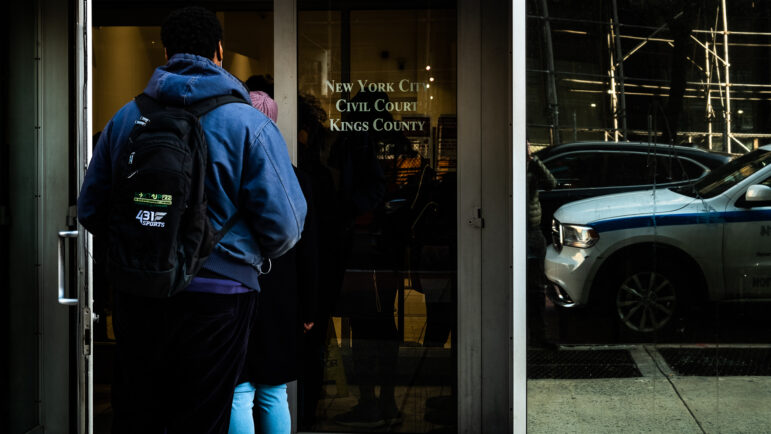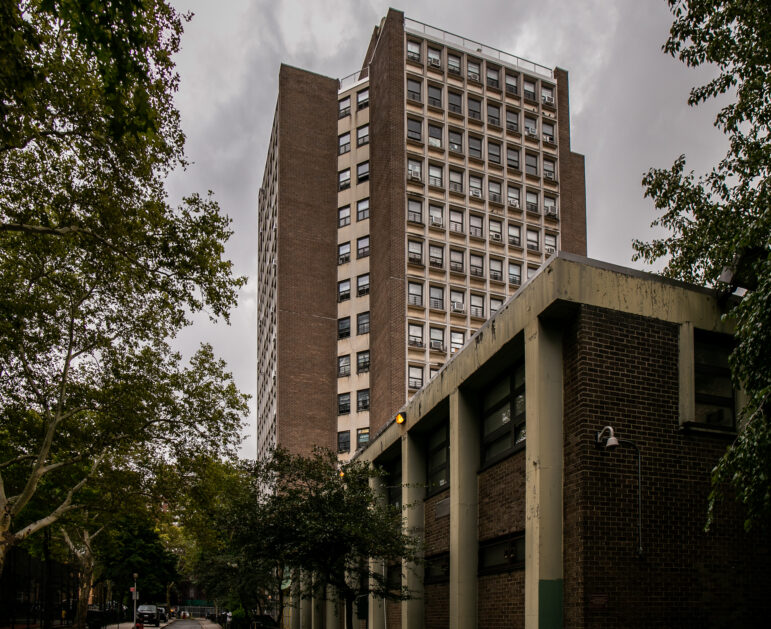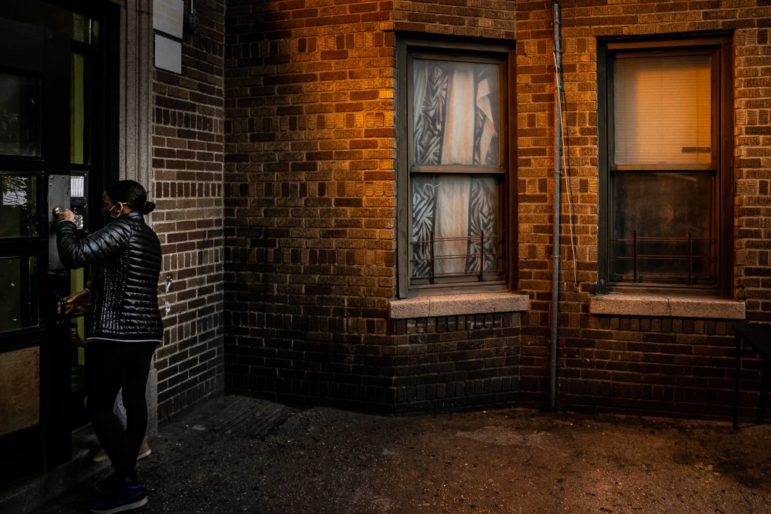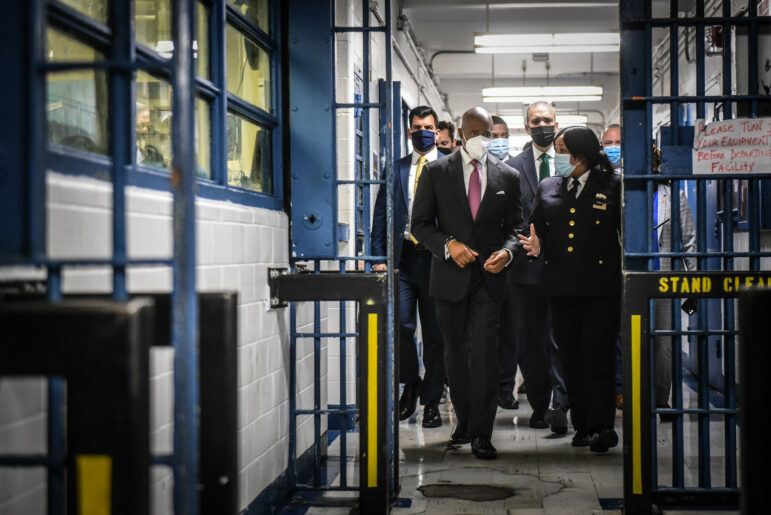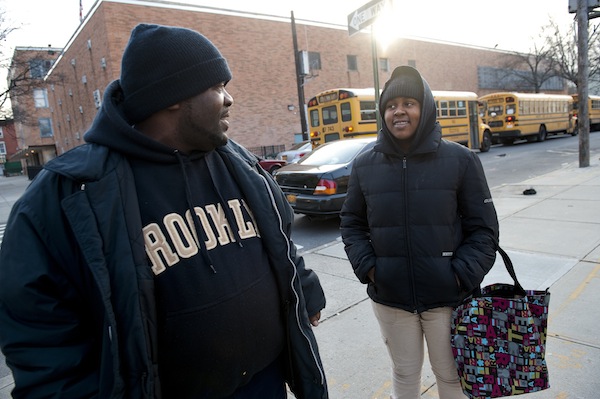
Photo by: Matt Moyer
Ronald Johnson and his daughter Felicia in 2012. The two are part of a pilot program to provide supportive housing to families involved in the child welfare system.
Felicia, 15, says people tell her she and her dad argue like an old married couple. He nags her to clean up after herself; she nags him to quit smoking. She has perfect school attendance, she says, because of her father’s eagle eye.
It’s against this backdrop of domesticity and fastidious parental oversight that Ronald’s account of his past is so jarring
There’s the dreamlike story Ronald tells of how, in his 20s, shortly after his marriage broke up, he met a truck driver looking for directions to the Piggly Wiggly warehouse, and decided to ride with him from South Carolina all the way to Florida. There are the months he spent in Okala, living in a warehouse once used for storing chickens, lying awake listening to the rats running through the walls at night. There’s the year and a half he spent living on the New York City streets, washing up in a Kinko’s restroom in the morning, working as a cook all day, and finding a dark spot to curl up in at night.
When Felicia was born, and her mother proved unable to raise her, Ronald’s focus became on creating a more stable life for his daughter himself. Then came the day he arrived late from work, found a shelter worker had handed Felicia over to child protective services, failed a drug test, and lost his daughter to foster care.
Eventually, though, that led Ronald and Felicia to Keeping Families Together (KFT), one of the first supportive housing projects in the country created with the primary intent of keeping children out of foster care.
A new model
Supportive housing starts with a simple premise: that it’s hard for people to attend to their higher order needs—mental health, sobriety, healthy parenting—when they can’t meet basic needs, like housing. It’s founded on the idea that if you house people, and connect them to the services they choose rather than mandate services, eventually many of them will find their own way to sobriety and stability. It’s a model long used with mentally ill or drug-addicted adults. But supportive housing for at-risk families is new, though studies have long shown that parents who experience homelessness are far more likely to lose their children to foster care than other low-income parents, while one study from the late 1990s showed that a family’s chances of child welfare involvement nearly doubled within one year of entering the shelter system.
Run by the Corporation for Supportive Housing (CSH) and funded by the Robert Wood Johnson Foundation, KFT is home to 26 families, with housing and support services contracted out to six privately operated sites around the city. It’s a small enterprise, but it demonstrates the potential benefits as well as the real daily challenges of supportive housing as a way of addressing chronic homelessness and chronic child maltreatment.
These are pressing issues in New York, where more than 22,000 New York City children experience homelessness each night, according to the Coalition for the Homeless, while the 17% of homeless who are chronically so use 50 percent of homelessness resources, according to the Center for Urban Community Services. Adding to the urgency for new solutions, this year the state’s Office of Children and Family Services found that within 18 months, 43.6 percent of families reported to child protective services in 2011 were re-reported, while one in six children who returned to family after a stint in foster care returned back to care within 18 months.
This contrasts with the relative stability experienced by families in Keeping Families Together, where all six children in foster care with a goal of reunification when KFT began in 2007 had returned to family for an average of 15 months at the end of the pilot three years later. Three heads of household left KFT voluntarily, in part because they needed more intensive treatment, such as inpatient rehabilitation services to deal with addiction. But those that stayed saw a significant decrease in child welfare involvement. While 13 new cases of abuse or neglect were indicated in the three years after move in, this contrasts to the 46 indicated cases in the three years before.
Moreover, no new children entered foster care as a result of those cases. Elisa Barnes, former counsel for parents in Manhattan’s family court and a supportive housing activist, says she believes that’s because workers at supportive housing sites can vouch for a family even in the midst of a crisis. As a result, she says, child protective workers and family court judges are less afraid that if they leave a child in a home, “something terrible will happen, or that they’ll be the ones who are vilified”—while families have a chance to stabilize their lives without the upheaval of losing their children, which can send families into a further downward spiral. “Even young children, when they reunify, feel like their parents have abandoned them and are angry. It’s hard enough for happy, well-adjusted parents when their children are screaming and acting out. It’s that much harder for vulnerable parents,” says Barnes.
After one year, school-aged children were also attending 25 more days of school per year, on average, according to an independent evaluation conducted by Metis’ Associates. Improved attendance did not significantly change academic achievement, with most children still failing to meet state standards in math and English. Nonetheless, attendance, in and of itself, can be an important indicator that children are living lives not marked by chaos, but with a sense of order and stability.
Hard lives
When Keeping Families Together began, the goal was not just to provide housing, but to help parents reverse patterns of suffering and instability that had often started in their own childhoods, and continued.
To be eligible, all families had to have been chronically homeless, have a head of household who was substance abusing or mentally ill, and have children in foster care or at risk of placement. Half the heads of household also reported that their own parents abused drugs or alcohol; almost a third said they’d lost a parent to death or abandonment; more than a quarter reported being sexually abused as children; and more than a quarter said they’d spent time in foster care. As adults, three quarters reported being victims of domestic violence; one quarter said they’d been raped; three quarters suffered from depression; and more than a third said they’d thought about committing or had attempted suicide.
Many had stories of unresolved loss like Ronald’s, who spent his early years down south with his grandmother, whom he considered his mother and with whom he felt a loving bond. Then, when he was 8, his family uprooted him to the Bronx to live with a mother he hardly knew, and a stepfather who was violent with them both. It was his inability to come to terms with the violence and loneliness he encountered, Ronald believes, that led to his years of drug use, and the long stretches he spent in shelter and on the street, even while he worked and took care of his daughter.
People typically under-report the traumas of their lives, and it’s reasonable to assume that the KFT numbers are, in fact, low. Still, what they suggest is that, left unattended, trauma can create a kind of No Exit of suffering that continues from generation to generation.
It was that No Exit that the Robert Wood Johnson Foundation was trying to escape when it first came to CSH looking for a better way to do child welfare. It was 2006 and yet another child known both to the child welfare system and to the shelter system, Nixzmary Brown, had just met an unbearably brutal end. There were questions all around about why no one had known, no one had seen, and why Nixzmary hadn’t been taken out of her home while there was still time to save her.
But there was also growing concern that placement in foster care could be a wound to children’s sense of their place in the world that could be hard to ever recover from.
Research had already shown the stark outcomes for children who aged out of foster care, including rampant homelessness. Then, in 2007 and 2008, an economics professor from MIT’s Sloan School of Management, Joseph Doyle, released two studies showing that even compared to comparably abused and neglected children left in their homes, children placed in foster care were more likely to become teen parents, spend time in a juvenile justice facility, have trouble holding down a job, and be arrested as adults.
Doyle factored out the most egregious cases of abuse and neglect. He looked only at cases where a child protection agency might have reasonably decided to leave a child at home or place that child in foster care. Nonetheless, his findings were troubling. How could the government justify the massive intrusion into a family’s autonomy and the huge expenditure of public dollars if child protection proved another trauma in an already troubled life?
More trust for clients
In many ways, what supportive housing offers is a messier model.
That’s because, philosophically at least, supportive housing starts with a belief in the value of people’s autonomy. “We don’t begin with the premise that you’re endangering your child. We’re not looking for clues,” says Mary McKay, professor at New York University’s Silver School of Social Work and clinical consultant to KFT. “Until proven otherwise, we assume that choices build health and strength for caregivers, and healthy adult role models for children.”
This is different from the child welfare system, where, typically, parents are mandated to participate in drug rehab, or parenting classes, anger management, or therapy—services that can be pivotal in helping some parents turn around troubled lives, but which can also be too generic to be much use to other parents, who are often too scared and angry to be open to them anyway.
By contrast, in supportive housing, the only obligation on residents is that they participate in regular meetings with a case manager. Beyond that, parents are free to say, “That’s just not something my family needs,” even if the case manager strongly believes the family does.
Nor do families automatically lose their housing, or their children, if parents are using drugs or behaving erratically. KFT’s housing is meant to be permanent, relying on frontline workers having the skill to safely ride it out with parents struggling with sobriety and depression, wary of services, and trying to cope with the challenging behaviors of children dealing with their own trauma history.
For Ronald, that respect for keeping families together has been reassuring. When Felicia was 3, she and Ronald moved to a shelter. One night when Ronald was stuck in traffic coming home from work, Felicia’s day care called the shelter, the shelter worker called child protective services, and child protective services decided to drug-test Ronald. Ronald says he’d cut back on his drug use after Felicia was born, but that day, he tested positive for cocaine, and Felicia was taken into foster care.
“It was rough,” Ronald recalls. “She was going through mad changes. She wasn’t used to being away from me. I can’t do nothing.” Ronald did a stint in rehab, and after a month, Felicia came home. But Ronald continued to live with the fear of another report and another removal. That eased after he moved into KFT housing in Brooklyn run by CAMBA, one of the non-profits KFT contracts with.
While reassuring for residents, KFT’s respect for autonomy can be hard for workers to manage. After the project started, administrators realized that case managers were overwhelmed, leading some to want to respond quickly with the strong arm of mandated reporter. “At the beginning of this project, there were lots of judgments,” acknowledges Alison Harte, the Corporation for Supportive Housing’s point person overseeing KFT. “Providers would say, ‘I’m a mandated reporter. If I see this or that I’m calling ACS.'”
In response, CSH hired McKay to help staff build trust and support families themselves when they showed little interest in outside services. She also helped them make sense of their role as mandated reporters. One site, Palladia, found money within their own budget to have McKay supervise staff on a weekly basis to help them remain stable in the midst of so much instability.
Still, some sites proved more skilled than others in engaging families in addressing their problems, while some workers reported continued confusion about how to negotiate the tradeoff between respect for autonomy and child well-being. Meanwhile, in an independent evaluation done by Metis’ Associates, some residents reported feeling watched and judged, just as they had when they were living in a shelter. As one parent, quoted in the evaluation, explained: “Supportive housing needs to find a happy medium between being supportive and being in people’s business.”
Difficult calls
Emily Wyman is the Clinical Supervisor at Palladia’s Fox Point, a supportive housing site in the Bronx where four KFT families live. Wyman has a soft voice and a calming demeanor, and has proven particularly adept at providing the support that allows families to manage their own crises. At the same time, she acknowledges, there are instances when she and her staff feel compelled to step in and say, “I’m sorry, but you aren’t managing adequately.”
There’s the mother who wanted to solve problems by fighting and having her kids fight. One teenage son also had violent outbursts, even breaking the building’s lobby door. Still, when he grew violent, staff went to mom to figure out parenting strategies with her, showing they respected her role as parent. “She’d ask us, ‘I’ve allowed my sons to fight, so how can I get upset?’…We’d ask her, ‘What lessons do you want to teach them?’ We just think about it as opening up a conversation, planting a seed.”
They also tried to help her question the impact of her continued marijuana use, though they didn’t require that she quit. Nor was any punitive action taken when she relapsed on crack. “She felt ashamed,” Wyman recalls, “and we spent a lot of time working through those feelings. I helped her understand that relapse is part of recovery.”
There are times, though, when Wyman and her staff have turned to child welfare to intervene.
About a year ago, Wyman recounts, her staff decided to call child protection about a young couple’s physical fights. When Wyman or her program director makes such calls, they discuss the reasons for the call with parents in advance, and they invite parents to be there for the call. Their goal is to allow the family as much control as possible in an out-of-control situation.
After Wyman placed the call, child welfare sent the couple to anger management and drug rehab, and Wyman saw them stabilize without losing their children. Still, Wyman says, “They were very upset with us…This call was made a year ago, but it wasn’t until recently that mom came in my office and actually had a conversation with me.”
But not making that call, Wyman acknowledges, poses dangers of its own. She and her staff are concerned about another mother, who was sexually abused as a child, and whose own daughter was sexually abused.
The mother has resisted taking her daughter to therapy. In part, Wyman believes, it’s the practicalities that stop her. Mom is phobic of being in crowds. “Even just going to an appointment, waiting to be called is a very big hurdle…We’ve said, ‘Mom, we’ll go with you,’ but mom is very blocked.”
Many parents in the program are also very distrustful of therapy, Wyman says. “They’ve been pushed around by so many people,” she explains. They’re scared of being forced to tell their secrets. “They feel that nobody actually cares how they feel anyway,” says Wyman.
Wyman says the staff at Fox Point try to understand. Still, they wonder if allowing mom to refuse her daughter treatment constitutes neglect. Recently they’ve seen behaviors in mom’s 6-year-old son that seem overly sexualized and make them worry.
Wyman says if mom doesn’t take steps to take her daughter to treatment, they may have to call child protective services. “I always stress to my staff, we have to be mindful how we talk to tenants. We don’t want mom to feel threatened. But at same time she needs to know what our stance is…As her daughter gets older, we don’t want her to be a runaway. We want to break that cycle.”
Expansion ahead
This past year, Keeping Families Together received funding from the U.S. Department of Health and Human Services’ Administration for Children, Youth and Families as well as from four foundations—Robert Wood Johnson, Annie E. Casey, Casey Family Programs and Edna McConnell Clark Foundations—to expand the pilot to San Francisco, Memphis, Cedar Rapids, Iowa, Broward County, Florida and the state of Connecticut, serving, in all, approximately 600 families. Each locale will receive $5 million over a five year period, with an additional $10.5 million available from the foundations for additional supports. The pilots will be evaluated by the Urban Institute and receive support from CSH and the Center for the Study of Social Policy.
Ryan Chao, Annie E. Casey’s vice president for civic sites and community change, says he believes “success in multiple states could lead to continued expansion of the model.” Indeed, New Mexico has just passed legislation for 50 units of supportive housing called Keeping Families Together, while New Jersey has come through with funding for 10-15 units.
Advocates acknowledge that supportive housing for families requires a large investment upfront. A cost analysis done by Metis Associates concluded that KFT cost $3 more per day than it would cost to house those same parents in homeless shelters and their children in foster care. Moreover, if supportive housing is done badly, it runs the danger of being neglectful, or heavy-handed, or both.
Still, Andy McMahon, managing director of CSH’s government affairs and innovations, believes money for housing could come from efforts to restore federal Section 8 special purpose vouchers lost in federal budget negotiations in 2012, as well as from the existing supportive housing agreement between New York City and state. Funding for services, he argues, could be redirected from child welfare’s preventive services budget, or could be written into proposals to renew New York’s federal child welfare waiver, which allows it to invest monies saved from reduced child welfare rolls into preventive measures. KFT has made it through the first round of a request for proposals from the state’s Office of Children and Family Services but it is unclear whether the model will expand in New York.
Child and homeless advocates say they support the expansion of models like KFT for the highest-risk, highest-needs families exiting the shelter system. At the same time, they raise questions about who should be served by such models, and how to fund them adequately.
“Our biggest question is how deep into the child welfare system a family should have to get before getting into a program like this,” says Stephanie Gendell, Citizens’ Committee for Children’s associate executive director. “Is there a way that supportive housing could actually be more preventive—rather than a family having to have an indicated case before they receive supportive housing?”
Chris Estes, president and CEO of the National Housing Conference, says it’s important that supportive housing be complementary to other solutions to homelessness, rather than in competition with them. Estes also notes the importance of thinking about sustainability before models like KFT are expanded, so that when budget cuts come, case managers are adequately supported in carrying out the hard work of supported autonomy.
“These models don’t offer a quick fix,” says Estes. “This work is complicated and it takes patience…It has to be implemented using best practices by the right set of people.”
The long road home
Wyman understands that there’s no such thing as a quick fix.
She has seen children running the streets and using drugs, just like their parents did. But she has also seen vulnerable parents helped to stay strong through their children’s crises, and children who come out the other side more stable for it. To Wyman, as messy as it is, this is success. “It takes time for parents to tell their kids, ‘That’s not me anymore, that’s my past,'” says Wyman. “They have to show them, and that takes time.”
For Ronald, it’s a feeling of home that has taken a long time to achieve.
For seven years, Ronald lived with white walls, no pictures anywhere, afraid to disturb anything in his KFT apartment. But then Felicia began to complain that white made her feel “still institutionalized.” So just recently, Ronald allowed himself to get carried away with color, painting the walls a striking red, blue, orange and green.
As a final touch, he hung up two framed pictures of him and Felicia.
This sentence was corrected to include mention of CSH.


